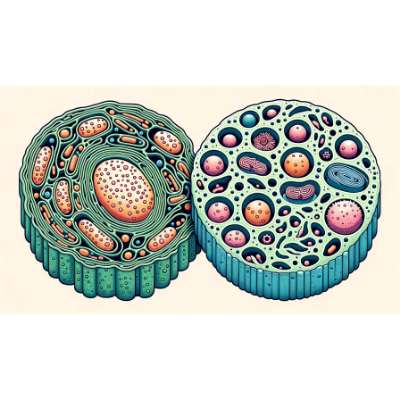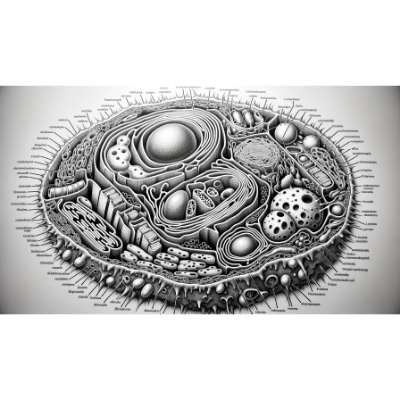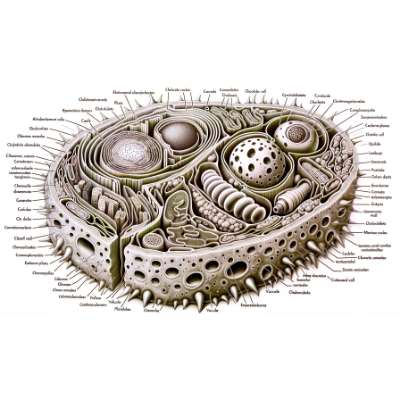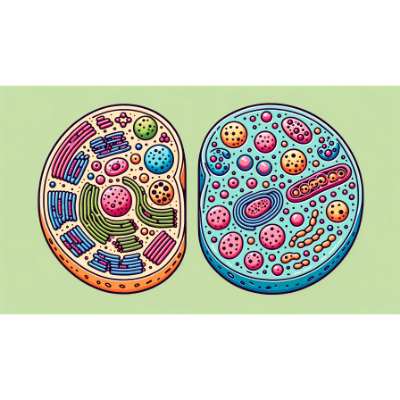In the vast world of biology, the microscopic realms of plant and animal cells reveal their distinct character. As I delve into this topic, we explore their differences, stark and clear.
Plant Cells
The Rigid Keepers
Plant cells, like disciplined sentinels, are distinguished by their robust cell walls, a fortress of cellulose that stands unwavering. Within their rectangular confines, they house chloroplasts, nature’s solar panels, converting sunlight into life-sustaining energy. This feature sets them apart from their animal counterparts, who lack this botanical prowess.
But that’s not all. Plant cells are nature’s hoarders, with a colossal central vacuole, a reservoir brimming with water, nutrients, and waste. It maintains turgor pressure, the secret to their upright stature.
In summary, plant cells are the rigid custodians of life, fortified by cell walls and energized by chloroplasts.




Animal Cells
Flexibility and Adaptability
Animal cells, in contrast, are the embodiment of flexibility. They dance to the rhythm of change, with plasma membranes that bend and shift like the ebb and flow of the tides. These membranes are the very essence of their mobility, vital for muscle contractions and cellular motion.
Centrioles, those unassuming cylinders, orchestrate the grand spectacle of cell division in animal cells, a role denied to their plant cell counterparts. These structures are the conductors of life’s symphony, ensuring the correct allocation of genetic material.
In the energy realm, animal cells march to a different beat. They are consumers, not producers, relying on external sources for sustenance. Chloroplasts are but a foreign concept, their energy production delegated to the consumption of plants and other animals.
Animal cells are complex, with a diverse array of organelles, each with its specialized function. Lysosomes, akin to cellular demolition crews, break down waste, while mitochondria, the powerhouses, generate the much-needed energy.
In essence, animal cells thrive in their adaptability, with plasma membranes that flex and organelles that cater to their diverse needs.
The Side-by-Side Comparison
Divergent Realities
Let’s lay it out, side by side, to see the tapestry of differences woven between plant and animal cells:
| Feature | Plant Cells | Animal Cells |
|---|---|---|
| Cell Wall | Present (rigid, cellulose) | Absent |
| Chloroplasts | Present (for photosynthesis) | Absent |
| Central Vacuole | Present (large, for storage) | Smaller or absent |
| Plasma Membrane | Present (flexible) | Present (flexible) |
| Centrioles | Absent | Present (during cell division) |
| Chloroplasts | Absent | Present (for energy production) |
| Organelles | Fewer and less diverse | More diverse |
In this visual juxtaposition, the distinctions between plant and animal cells come into sharper focus. Each feature tells a tale of adaptation, revealing the different paths evolution has carved.
People also ask Questions and Answers:
1. How do plant and animal cells differ in terms of cell walls and membranes?
In the realm of cellular distinctions, the most conspicuous difference between plant and animal cells lies in their fortifications. Plant cells, unyielding like seasoned soldiers, possess rigid cell walls, a defining characteristic absent in their animal counterparts. These walls, constructed of cellulose, provide structural support and protection, forming a barrier akin to a fortress. In contrast, animal cells are encased in flexible plasma membranes, granting them the ability to adapt and change shape, much like the fluidity of the sea.
2. What sets apart the energy production mechanisms in plant and animal cells?
The energy dance in the microscopic world unfolds differently for plant and animal cells. Within the chloroplasts of plant cells, nature performs alchemy, transforming sunlight into life-sustaining energy through photosynthesis. This unique capability bestows plants with the title of primary producers. In contrast, animal cells, devoid of chloroplasts, do not possess this photosynthetic magic. They are consumers, drawing energy from the consumption of plants or other animals, creating a distinct ecological web.
3. Are there differences in organelles between plant and animal cells?
Within the cellular orchestra, the players differ between plant and animal cells. Animal cells boast a more diverse ensemble of organelles compared to their plant cell counterparts. These include lysosomes, the cellular demolition crew, and mitochondria, the tireless powerhouses. Plant cells, on the other hand, keep their organelle lineup more restrained. This diversity in organelles reflects the unique needs and functions of these cells within their respective organisms.
4. How do plant and animal cells handle waste disposal?
Waste management takes on distinct forms in plant and animal cells. Animal cells rely on lysosomes, cellular scavengers filled with enzymes, to break down and dispose of waste materials. In contrast, plant cells utilize a large central vacuole as their waste reservoir. This vacuole helps maintain turgor pressure and stores various substances, including waste, contributing to the rigidity and structure of plant cells.
5. What role do centrioles play in cell division, and do both plant and animal cells have them?
Centrioles, unassuming cylindrical structures, serve as the conductors of the cell division orchestra. They ensure that during cell division, chromosomes are correctly distributed to the newly formed cells. While animal cells possess centrioles, plant cells do not share in this cellular choreography. This difference highlights the unique mechanisms of cell division between the two cell types.
6. Are there any similarities in the internal structure of plant and animal cells?
While plant and animal cells exhibit striking differences, they do share some commonalities. Both possess a nucleus, the command center of the cell, where genetic information is stored. Additionally, both cell types contain organelles such as the endoplasmic reticulum and Golgi apparatus, which play roles in protein synthesis and processing.
7. How do plant and animal cells adapt to their respective environments?
The differences in cell structure between plants and animals reflect their adaptation to distinct environmental challenges. Plant cells, with their rigid cell walls, are well-suited for standing tall and capturing sunlight. This enables them to thrive in diverse terrestrial environments. Animal cells, with their flexible plasma membranes, excel in adaptability and mobility, allowing animals to navigate their varied habitats.
8. What is the significance of the large central vacuole in plant cells?
The large central vacuole in plant cells is akin to a reservoir of life. It stores water, nutrients, and waste, playing a pivotal role in maintaining turgor pressure, which keeps plant cells taut and upright. This vacuole is essential for the structural integrity of plants and their ability to survive in fluctuating environmental conditions.
9. How do plant and animal cells differ in their approach to obtaining energy?
In the quest for sustenance, plant and animal cells take different paths. Plants, equipped with chloroplasts, harness the power of sunlight through photosynthesis, producing their own energy. Animals, lacking chloroplasts, rely on consuming plants or other animals to obtain the nutrients and energy they need. This divergence in energy acquisition shapes the ecological relationships between these two cell types.
10. What insights do the differences between plant and animal cells offer about the diversity of life?
The distinctions between plant and animal cells unveil the rich tapestry of life’s diversity. They underscore the ingenious adaptability of living organisms, each evolving to excel in its unique ecological niche. Understanding these differences not only enhances our grasp of biology but also deepens our appreciation for the intricacies of the natural world, where life’s myriad forms find their place in the grand design.
In Conclusion
Nature’s Ingenious Designs
In the grand tapestry of life, plant and animal cells occupy unique niches, each bearing the hallmark of its purpose. Plant cells, with their robust cell walls and chloroplasts, stand tall as the architects of photosynthesis. Animal cells, with their flexible membranes and diverse organelles, are the masters of adaptability.
Understanding these distinctions not only enriches our biological knowledge but also deepens our appreciation for the ingenious designs of nature. As we journey through the intricate world of cells, we unravel the mysteries that underpin life’s diversity.
As students, let us marvel at the elegance of nature’s solutions, for within these tiny cells lie the secrets of existence itself.
